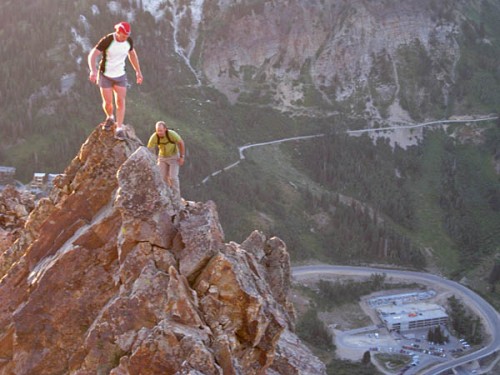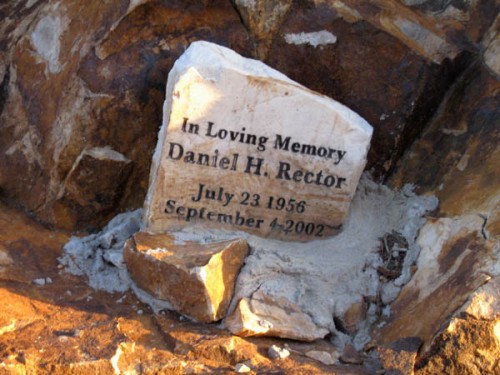The Theory of Relativity & Safety
A Dawn Patrol trip up the South Ridge of Mt. Superior this morning reminded me of an sobering lesson from 2002.
The first time I ventured up this ridge, I read about it in the local guidebook and brought along a rope and rock climbing equipment. The ridge turned out to be so straightforward and moderate that I never used any gear and subsequently did it many more times with increasingly less and less equipment until it had become a race track. There were plenty of willing partners and the faster we got, the easier it seemed. At one point someone asked how hard it was and I remember saying that it had some exposure, but you’d have to try to hurt yourself if you fell.
On September 4th, 2002, I was proved wrong on this theory when a close friend, Dan Rector, slipped and fell to his death. Dan was about 100′ feet behind on an exposed ridge just as the sun was coming up when I heard him say “whooah…” and then tumble off the ridge. I’ll never know if it was loose rock, missed handhold or an untied shoelace, but the underlying premise was that we had become inured to the danger and exposure to the point where we considered it safe, easy ground, which in reality it is not.

- Courtney Phillips (followed by Matthew Turley) at the point where Dan fell. It seemed safe at the time.
In terms of skiing, the same thing happens. The longest fall I’ve ever taken took place on a run which I’d skied so many times it seemed boring and I let my guard down. Five-hundred vertical feet later, I was amazed to be alive and had a new perspective on “safe” terrain. More than any single run, it changed the way I ski. The lesson I took away from this is that at times, under-rating moderate terrain can be far more dangerous than being fully engaged when the dangers are obvious.
Any similar experiences?
________________________________
Help support StraightChuter.com and get my lightweight helmet of choice, the Black Diamond Tracer on sale now at Backcountry.com! Click on the photo below…
Category: 12 Staying Healthy











True enough. It seems like a lot of climbing/skiing accidents happen on relatively “safe” terrain/routes. It is easy to forget that a slope that we can do with our eyes closed can cause a lot of damage. RIP Dan.
It is easy to become complacent and often times the end net result of a miscalculation is not taken into the equation on “easy” ground. I have seen so many examples of the easy terrain being by far the most dangerous terrain.
After my hardest ice lead in Provo canyon I slipped at the base of the climb and took a couple of hundred foot fall down an ice boulder slope. It wasn’t the vertical water ice that nearly killed me, it was the 5 degree ice slope at the base that I slipped on.
I miss Dan and his zest for life. He lived life well.
-Brad B
Inured, good word usage. Looks like we’re coming up on the anniversary of Danno’s fall, possibly just in time for some snow as well. I had only met and talked to Danno a few times, once in Wolverine Circus for Summer skiing and another in Silver Fork. He certainly seemed to enjoy getting out there.
I remember doing the south ridge for the first time with you and Dan a few weeks before that accident.
This spring I lost a close friend, Lathrop Strang, skiing up on Sopris, here in the Roaring Fork valley. Lathe had skied up there every year since the mid 80s. Where he fell was super steep terrain but well within the realm of his talent.
Risk is relative. Consequence is not.
Hi Penn – I remember reading about that accident.
On a related note, years ago I was talking to a Yosemite Big Wall master and he was saying that he was so focused when doing hard A4/A5 aid climbs that he never fell, and A1 climbs were so secure that he never fell on those either, but it was middle A2/A3 zone where he took his biggest whippers because he was moving fast on familar ground.
The only time I’ve ever decked happened on an easy 5.8 that I was familiar with. I let my wide belay much further back than she should have (because it was easy) and I was climbing fast and loose (because it was easy) when I stepped on my rope on a traverse with too much slack, slipped and landed flat on my back and head. Luckily I was only 10 feet off the deck about to clip the 2nd bolt, so I was able to suck it up and finish the climb but it definitely opened my eyes to where the real danger lies: complacency and arrogance.
Awesome post; stuff I think about often, too. Sometimes it seems like the things we come to take for granted and the things we fear unreasonably are remarkably similar, e.g., I warm up on routes that I’d be horrified to fail on. Likewise, Arnie sniffs the butts of dogs who like to bite him (Red).
I’m glad you guys continue to run up Superior, but I’m glad you think about it, too.